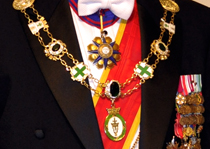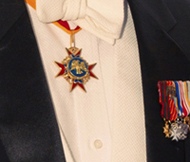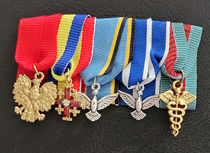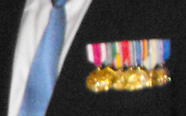
|
History
of the Noble Company |
Guide
to the Wear of Decorations |
These guidelines follow the customs of the Pontifical Imperial State and are therefore broadly applicable to a wide variety of nations and customs. There is no universal set of rules, however, for the wear of decorations.
For information on registering a coat of arms or obtaining a grant of arms, please click here.
|
White Tie, Court Dress, and Full Dress Uniforms Gentlemen Consists of black tailcoat and trousers (usually with satin double or single stripe), white piqué shirt with wing collar, white piqué waistcoat with lapels and three buttons, white piqué bow tie. The most traditional shoes are black leather or patent leather pumps, which often have a grosgrain bow. Black lace ups are usually appropriate if not overly bulky. White formal gloves are used. The proper hat is a top hat. There are variations in uniforms, national dress, etc. Specific components are detailed in the regulations pertinent to each uniform. 1. Rarely is more than one sash worn. Which sash to wear? Usually the sash of the highest grand cross held is worn. This may be varied according to the event being attended or, as appropriate, according to personal preference. If attending an event of a foreign country or outside organisation, and a sash of an honour therefrom is held, then protocol usually expects the wear of the host country's or host organisation's decoration. The same principles apply to neck badges and stars. This, however, is very situationally dependent. Also, those who hold the grand crosses of certain sashes may by custom of those orders wear the sashes of both, with that of the higher-ranking order atop the other.
2. One neck badge/cross or an order or decoration may be worn with white tie and tails (note that some traditions permit two to be worn, with the higher badge woen over the lower-ranking badge). If two grand crosses are held, the less senior may generally be worn on a neck ribbon. If a sash is worn, a neck decoration is optional unless specified in regulations. However, with a high-collared uniform, generally up to three neck decorations may be worn, as governed by the pertinent uniform regulations. The highest order is worn at the neck, the second from the second button, and the third from the third button.
3. The stars of the orders are worn in order of precedence. If two stars are held, then that of the higher order, even if of lower rank, is worn above the other, frequently with the two stars forming a vertical line. However, the line may be skewed as deemed necessary for practical or aesthetic purposes. Sometimes two stars are worn in a horizontal line, though this is more common on uniforms than with white tie and tails. If stars of three orders are held, then they are commonly worn in a triangular formation, with one above two or two above one. If four stars are worn, then the fourth is typically worn below the line of the second and third with the four stars forming a general pattern of a diamond. Occasionally, merit stars and some other stars and crosses are specified in the regulations to be worn on the right side. 4. Miniature medals are worn at the discretion of the wearer, unless specifically required by uniform regulations. Miniature medals, if worn, should be mounted. These are usually on a single bar, but this varies by country. On a single bar they may be swing mounted (each medal hanging from its own ribbon drape and left to swing free), court mounted (each medal from its own ribbon drape attached to corresponding backing ribbons covering a rigid board; the medals are then sewn to the board to prevent swinging), or pontifical court mounted (suspension ribbons brought through horizontally similar to a neck badge, with or without the ribbons behind the medals).
5. On particularly formal or ceremonial occasions, a grand collar may be worn. The specific wear of the collar is typically given in the rules of the order. Typically they are pinned in the middle at each shoulder so that approximately half of the collar is in the front, and half is in the back. Ladies Ladies' full dress attire consists of a formal, full-length gown (either ankle-length or full-length, with or without a train), and appropriate evening shoes. If the gown is sleeveless, then most formally, elbow gloves are worn. Hats are generally considered inappropriate with this level of dress, as are fascinators, unless the weather is cold enough to require it.
1.
The principles that apply to sashes worn by gentlemen generally
apply to ladies. Black Tie (Smoking) Gentlemen Black tie, or general evening dress for a gentleman consists of a black evening jacket in a similar cut to a business suit, a black waistcoat, a white shirt with pleats and either a winged collar or a standard turn-down collar (usually a winged collar is considered too formal, but is certainly not incorrect), and a black bow tie. Shoes and gloves are as given for white tie above. The correct hat is either a top hat or a Homburg, both in black. A fedora or similar hat should be avoided, but is often considered tolerable when worn by college students or young men due to the expense of the other hats. In summer or in tropical areas, regardless of the time of year, a white dinner jacket is acceptable, though not required. The white jacket may be worn with a black waistcoat/cummerbund or alternatively with a white waistcoat of appropriate lightweight material. An appropriate straw hat may be worn. Variations to the black evening jacket exist. Black tie uniforms have their own regulations. As given for white tie, except that sashes usually are not worn. If the occasion warrants usually only one sash is worn. Also, usually no more than one star is worn, but this may vary according to the occasion. With civil dress, one rosette or other similar miniature informal insignia may alternatively be worn in place of all other decorations.Ladies Ladies' formal evening wear equivalent to black-tie typically consists of a formal evening gown that may be floorlength (always without a train) or to just below the knees. Gloves usage and style depends on the occasion and personal preference. As with full dress, hats and fascinators are not used in less the weather is sufficiently cold to require it. Ladies wear decorations pendant from a bow pinned to the left side of the dress, either full-size (equivalent to a gentleman's neck decoration) or in miniature. In its most simple form, usually only one such decoration is worn, and sizes are not mixed. One or more stars may be pinned to the dress as usual. As for gentlemen, the type and number of decorations should correspond to the formality of the event (see gentlemen's black-tie, #1-5 above).
Morning Dress Gentlemen Gentlemen's formal morning dress consists, most formally, of a cutaway style morning coat in black, with dark grey or light grey trousers, which most traditionally are striped. The waistcoat is either grey or black. The shirt is white with a winged collar. Shoes are black, either slip-on or lace-up. The tie typically is black or grey, plain, striped, or spotted, and is either in the four-in-hand or ascot style. Sometimes a bow tie may be used. The correct hat is a black top hat. The gloves are grey. Less formally, the cutaway coat may be grey, in which case the top hat and gloves are both grey. On some less formal occasions, coloured ties may be used. When used as daily dress, the general trends above are followed, except that the coat is not a cutaway, but rather a stroller, similar in style to a business suit. The trousers may be plain or striped. The hat may alternatively be a black or grey Homburg or fedora.
Sashes generally are not worn, but are on occasion. If used, they are usually worn underneath the coat with civil dress. With civil dress, usually only one neck badge and one star may be worn, but depending on the circumtances, as many stars as may be worn with white tie and tails may be worn. This also varies for uniforms and clerical dress according to regulations. The specific decorations and number of decorations worn with morning dress should correspond to the formality of the event. One rosette or other similar miniature informal insignia may alternatively be worn in place of all other decorations. Miniature medals are not worn. Large medals, if worn, should be mounted. These are usually on a single bar, but this various by country. On a single bar they may be swing mounted (each medal hanging from its own ribbon drape and left to swing free), court mounted (each medal from its own ribbon drape attached to corresponding backing ribbons covering a rigid board; the medals are then sewn to the board to prevent swinging), or pontifical court mounted (suspension ribbons brought through horizontally similar to a neck badge, with or without the ribbons behind the medals). Ladies Morning dress for ladies consists of a daytime formal dress typically from floorlength to knee-length. Short kid gloves may be worn. An appropriate formal hat or fascinator may be worn.
Lounge or Business Suits Gentlemen 1. The most appropriate insignia for a suit in general is a single rosette or similar informal miniature insignia. The miniature/informal badge of certain orders, such as the Pontifical Order of the Eagle or the Order of the Golden Fleece, maybe worn pendant from the buttonhole of the left lapel, provided that no medal bar is worn. 2. If worn, medals are full-size.
3. A single neck badge may be worn as the occasion warrants. 4. Stars and collars are typically not worn, but may be according to the occasion and circumstances. Ladies The customs pertaining to the wear of decorations are identical to those of gentlemen.
|
|
|
Entire Contents Copyright © 2008-2019. Noble Company of Saint Mary of Walsingham. All Rights Reserved.




